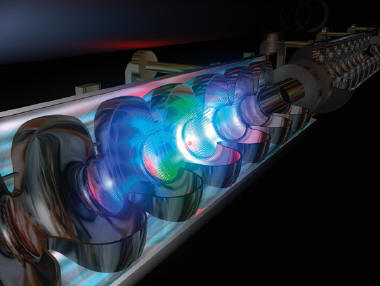What is Superconducting Radio Frequency (SCRF) Accelerator Technology?
The next generation of high power particle accelerators being developed for scientific applications are incorporating superconducting radio frequency (SCRF) technology into their design and fabrication. This technology greatly increases the energy per unit of length of the accelerating components of accelerators resulting in more powerful and smaller machines. While the scientific community has taken the lead and adopted SCRF into discovery science programs, the technology is evolving into other applications as it matures and industry across the globe gains experience in its development and manufacturing. Programs in various stages of design and development in the U.S. include the following activities:
- CEBAF UPGRADE: Continuous Electron Beam Accelerator Facility (CEBAF) upgrade at the Thomas Jefferson Laboratory in Newport News, VA
- SNS UPGRADE: Upgrade of the Spallation Neutron Source (SNS) at the Oak Ridge National Laboratory.
- US NAVY FEL: The Navy is developing a superconducting free electron laser (FEL) for defense applications.
- CORNELL ERL: Cornell’s Energy recovery Linac (ERL) will be located at the Laboratory of Elementary Particle Physics (LEPP).
- LBNE: Long Baseline Neutrino Experiment at Fermlab to further study the characteristics of neutrinos.
- PROJECT X: Fermilab’s planned Project X is an intense proton source that provides beams for various physics programs.
- FRIB: The Facility for Rare Isotope Beams (FRIB) at Michigan State University to study short lived isotopes.
- APS UPGRADE: Improvements to the Advanced Photon Source (APS) facility at Argonne National Lab .
- NGLS: UPGRADE: The Next Generation Light Source to deliver ultrafast pulses of x-ray light to understand several scientific process at the sub-atomic level at Lawrence Berkeley Lab.
- INTERNATIONAL LINEAR COLLIDER (ILC): The US is part of an international team ILC design team for this machine which incorporates SCRF technology for its damping rings and two 11 kilometer main linear accelerators.
- e-RHIC: A proposed high luminosity, polarized electron-ion collider at Brookhaven National Lab.
- NSLS II: National Synchrotron Light Source II, will produce x-rays more than 10,000 times brighter than the current NSLS and host a suite of sophisticated instruments for cutting-edge science, currently under construction at Brookhaven National Laboratory.




Connect With Us!
Contact Us Today For More Info